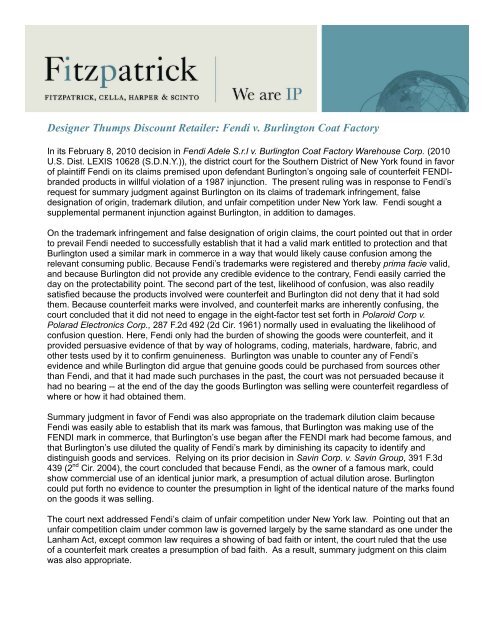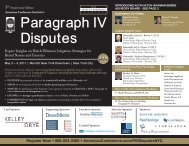Designer Thumps Discount Retailer: Fendi v. Burlington Coat Factory
Designer Thumps Discount Retailer: Fendi v. Burlington Coat Factory
Designer Thumps Discount Retailer: Fendi v. Burlington Coat Factory
Create successful ePaper yourself
Turn your PDF publications into a flip-book with our unique Google optimized e-Paper software.
<strong>Designer</strong> <strong>Thumps</strong> <strong>Discount</strong> <strong>Retailer</strong>: <strong>Fendi</strong> v. <strong>Burlington</strong> <strong>Coat</strong> <strong>Factory</strong><br />
In its February 8, 2010 decision in <strong>Fendi</strong> Adele S.r.l v. <strong>Burlington</strong> <strong>Coat</strong> <strong>Factory</strong> Warehouse Corp. (2010<br />
U.S. Dist. LEXIS 10628 (S.D.N.Y.)), the district court for the Southern District of New York found in favor<br />
of plaintiff <strong>Fendi</strong> on its claims premised upon defendant <strong>Burlington</strong>’s ongoing sale of counterfeit FENDIbranded<br />
products in willful violation of a 1987 injunction. The present ruling was in response to <strong>Fendi</strong>’s<br />
request for summary judgment against <strong>Burlington</strong> on its claims of trademark infringement, false<br />
designation of origin, trademark dilution, and unfair competition under New York law. <strong>Fendi</strong> sought a<br />
supplemental permanent injunction against <strong>Burlington</strong>, in addition to damages.<br />
On the trademark infringement and false designation of origin claims, the court pointed out that in order<br />
to prevail <strong>Fendi</strong> needed to successfully establish that it had a valid mark entitled to protection and that<br />
<strong>Burlington</strong> used a similar mark in commerce in a way that would likely cause confusion among the<br />
relevant consuming public. Because <strong>Fendi</strong>’s trademarks were registered and thereby prima facie valid,<br />
and because <strong>Burlington</strong> did not provide any credible evidence to the contrary, <strong>Fendi</strong> easily carried the<br />
day on the protectability point. The second part of the test, likelihood of confusion, was also readily<br />
satisfied because the products involved were counterfeit and <strong>Burlington</strong> did not deny that it had sold<br />
them. Because counterfeit marks were involved, and counterfeit marks are inherently confusing, the<br />
court concluded that it did not need to engage in the eight-factor test set forth in Polaroid Corp v.<br />
Polarad Electronics Corp., 287 F.2d 492 (2d Cir. 1961) normally used in evaluating the likelihood of<br />
confusion question. Here, <strong>Fendi</strong> only had the burden of showing the goods were counterfeit, and it<br />
provided persuasive evidence of that by way of holograms, coding, materials, hardware, fabric, and<br />
other tests used by it to confirm genuineness. <strong>Burlington</strong> was unable to counter any of <strong>Fendi</strong>’s<br />
evidence and while <strong>Burlington</strong> did argue that genuine goods could be purchased from sources other<br />
than <strong>Fendi</strong>, and that it had made such purchases in the past, the court was not persuaded because it<br />
had no bearing -- at the end of the day the goods <strong>Burlington</strong> was selling were counterfeit regardless of<br />
where or how it had obtained them.<br />
Summary judgment in favor of <strong>Fendi</strong> was also appropriate on the trademark dilution claim because<br />
<strong>Fendi</strong> was easily able to establish that its mark was famous, that <strong>Burlington</strong> was making use of the<br />
FENDI mark in commerce, that <strong>Burlington</strong>’s use began after the FENDI mark had become famous, and<br />
that <strong>Burlington</strong>’s use diluted the quality of <strong>Fendi</strong>’s mark by diminishing its capacity to identify and<br />
distinguish goods and services. Relying on its prior decision in Savin Corp. v. Savin Group, 391 F.3d<br />
439 (2 nd Cir. 2004), the court concluded that because <strong>Fendi</strong>, as the owner of a famous mark, could<br />
show commercial use of an identical junior mark, a presumption of actual dilution arose. <strong>Burlington</strong><br />
could put forth no evidence to counter the presumption in light of the identical nature of the marks found<br />
on the goods it was selling.<br />
The court next addressed <strong>Fendi</strong>’s claim of unfair competition under New York law. Pointing out that an<br />
unfair competition claim under common law is governed largely by the same standard as one under the<br />
Lanham Act, except common law requires a showing of bad faith or intent, the court ruled that the use<br />
of a counterfeit mark creates a presumption of bad faith. As a result, summary judgment on this claim<br />
was also appropriate.
Because the court determined that <strong>Burlington</strong> willfully infringed -- meaning it either knew its conduct<br />
represented infringement or recklessly disregarded the possibility -- it went on to find that for<br />
<strong>Burlington</strong>’s violations <strong>Fendi</strong> was entitled to treble damages and reasonable attorneys’ fees amounting<br />
to more than $4 million.<br />
In an attempt to head off future violations, <strong>Fendi</strong> also sought to supplement the 1987 injunction. The<br />
court adopted a $1,000 forward-looking sanction (i.e., $1,000 per each item sold in violation of the 1987<br />
injunction). It also ordered <strong>Burlington</strong> to both submit a written report outlining in detail how it planned to<br />
comply with the 1987 injunction going forward, and to thereafter submit, semi-annually for the next five<br />
years, reports on its full compliance with the 1987 injunction.<br />
<strong>Burlington</strong> was not the only entity left “holding the bag”, however. It was able to obtain indemnification<br />
from several of the vendors from whom it had purchased the products giving rise to <strong>Fendi</strong>’s claims, as<br />
these vendors had warranted the authenticity of their merchandise.








